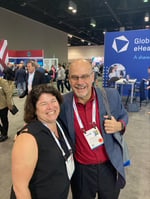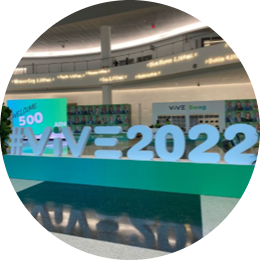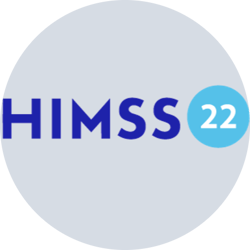HIT Perspectives
Subscribe
HIT Perspectives – April 2022
Take aways from HIMSS and ViVE
 By Tony Schueth, CEO & Managing Partner
By Tony Schueth, CEO & Managing Partner
Quick Summary
- The Point-of-Care Partners (POCP) team was in full force at HIMSS and ViVE
- Key takeaways:
- Health equity was everywhere
- No big announcements
- Payers had a big presence
- Smaller than expected public health footprint
- Buzz around meeting patients where they are
- HIMSS still seems to be the #1 conference for health IT
The spring conference season sprang back to life in March. This year kicked off with two in-person events: the annual meeting of the Healthcare Information and Management Systems Society (HIMSS) and the inaugural ViVE conference, co-hosted by CHIME and HLTH.

The Point-of-Care Partners (POCP) team was in full force at both conferences. It was great to catch up face-to-face with vendors, clients and doings by various stakeholders. We used our time productively by discussing issues and challenges with stakeholders, attending sessions, and presenting and seeing the latest and greatest in the exhibit halls. It certainly was worth the investment to be there in person and glean insights that just don’t translate fully — if at all — through virtual and/or smaller, more restrictive industry events.
Here are six of our meeting takeaways — what we observed and some things that surprised us.
1. Health equity was everywhere
Addressing health equity is a major trend in health care, so we weren’t surprised it was a focus. What was a little surprising is the sheer energy surrounding the topic and the number of sessions and presentations devoted to it, at HIMSS in particular. If the Gartner Hype Cycle is any guide, health equity is heading toward the peak of inflated expectations. That said, there is much work to be done and many initiatives are underway. Numerous sessions focused on efforts related to social determinants of health (SDOH). An example was a presentation on Gravity Project, which is developing SDOH standards that can be used for public health and other applications. A telling (and most likely prescient) observation was made by Micky Tripathi, who heads the Office of the National Coordinator for Health Information Technology (ONC). He noted that the ONC and Centers for Medicare and Medicaid Services (CMS) historically have focused on the HEALTH side of the Department of Health and Human Services (HHS); now, their policies and programs (and those of other agencies) are moving with renewed — and vigorous — emphasis on the HUMAN SERVICES side of HHS. (Click here to learn more about health equity in our primer in this issue of HIT Perspectives.)
2. No big announcements
HIMSS typically has been THE place for the government to drop new regulations and for industry to make major announcements about products, leadership and programs. There were a few this year but nowhere near as many as in past years. While there were a few new entrants looking to make a splash, there weren’t as many small startup players strutting their stuff and there were no huge giveaways or over-the-top advertising and massive parties. There were, however, a few mergers that were touted, such as the one between Lyniate and NextGate (two experienced vendors with complementary capabilities). We expect to see more mergers as the year wears on.
3. Payers had a presence
Payers were out in force this year. It’s clear they are ready to get back to business, especially when it comes to value-based care, the movement to which may have been put on hold during the heart of the pandemic. Payers were interested in ideas on how to gain interoperability with provider organizations. They also seemed to have gotten religion about HL7’s FHIR (Fast Healthcare Interoperability Resources) standard and FHIR-based application programming interfaces (APIs). There was considerable interest in the Da Vinci Project’s FHIR-based implementation guide for electronic prior authorization and related burden reduction. Other sessions and demonstrations on FHIR and the multi-stakeholder efforts to “accelerate” interoperability standards development also were very well attended. Payers will need help on going beyond basic compliance with federal interoperability regulations concerning FHIR adoption, creating patient-engagement tools through FHIR APIs and building a FHIR-based infrastructure.
4. Small footprints for public health and genomics
The Coronavirus disease-2019 (COVID-19) pandemic renewed interest in public health and shone a bright light on the fragmented, non-interoperable and under-funded public health system. That’s why we were surprised to see that public health had such a small footprint at both HIMSS and ViVE. The administration has announced that public health — and revamping the public health infrastructure — would be priorities. Yet there were no big announcements of what is coming down the pike. On the other hand, public health activities typically have been the purview of the American Public Health Association. Maybe more information on policies and programs will be available at its annual meeting in November. Genomics — a semi-hot topic in previous years — similarly had a very small presence. It’s also worth noting that there were few sessions on the COVID-19 pandemic per se. Perhaps this will be dealt with at other meetings and maybe everyone is ready to return to a sense of normalcy.
5. There was buzz around meeting patients where they are
There was a lot of interest at both conferences about long-term and post-acute care as well as home health, including “hospital at home.” There’s a lot going on in these spaces. Sessions underscored the continued movements toward aging in place and bringing technology-enhanced diagnosis and care to the elderly and chronically ill, no matter where they are. Tools, including telehealth and artificial intelligence, will continue to grow in importance.
 6. HIMSS is still the #1 meeting for health IT
6. HIMSS is still the #1 meeting for health IT
To be sure, ViVE and other meetings (such as ONC’s annual conference) are important, although ViVE seemed to be leaning more toward hospital systems than health information technology (health IT) in general. That said, HIMSS remains one-stop shopping for all things health IT and interoperability, unparalleled attendance by stakeholders and a platform for innovation and announcements. (For a detailed summary on VIVE, click here to read our blog.)
If you didn’t get a chance to attend HIMSS and ViVE, or you didn’t connect with the POCP team, reach out to me at tonys@pocp.com. We’d be happy to share in-depth insights and help you navigate the issues and challenges facing health IT this year.




